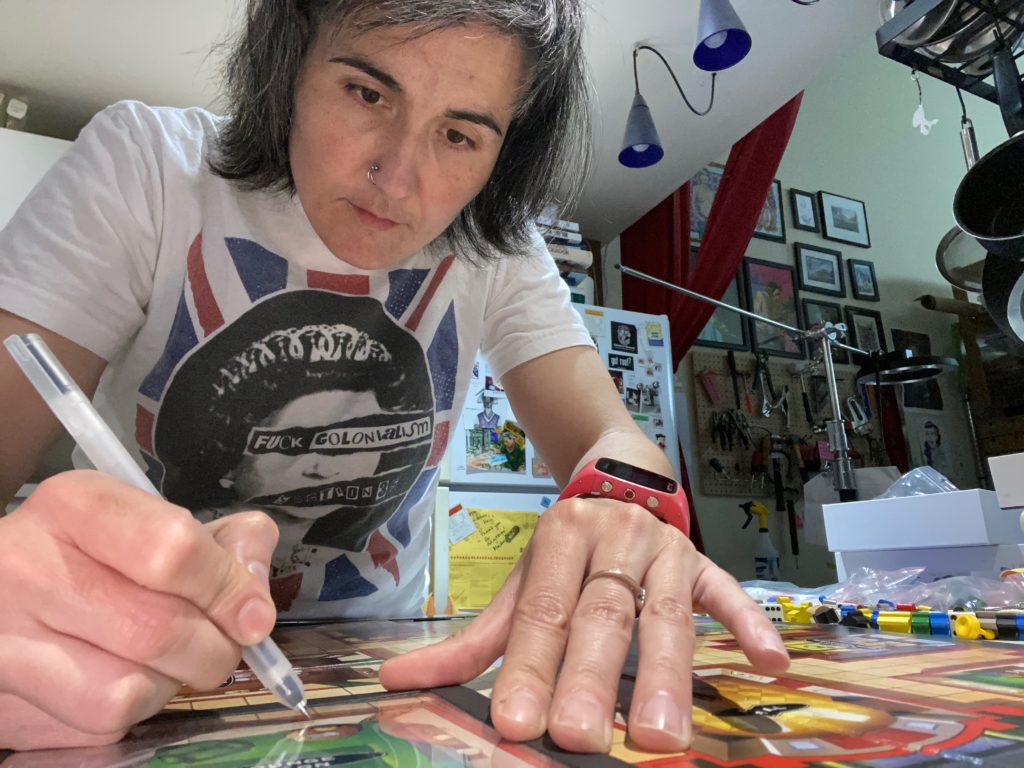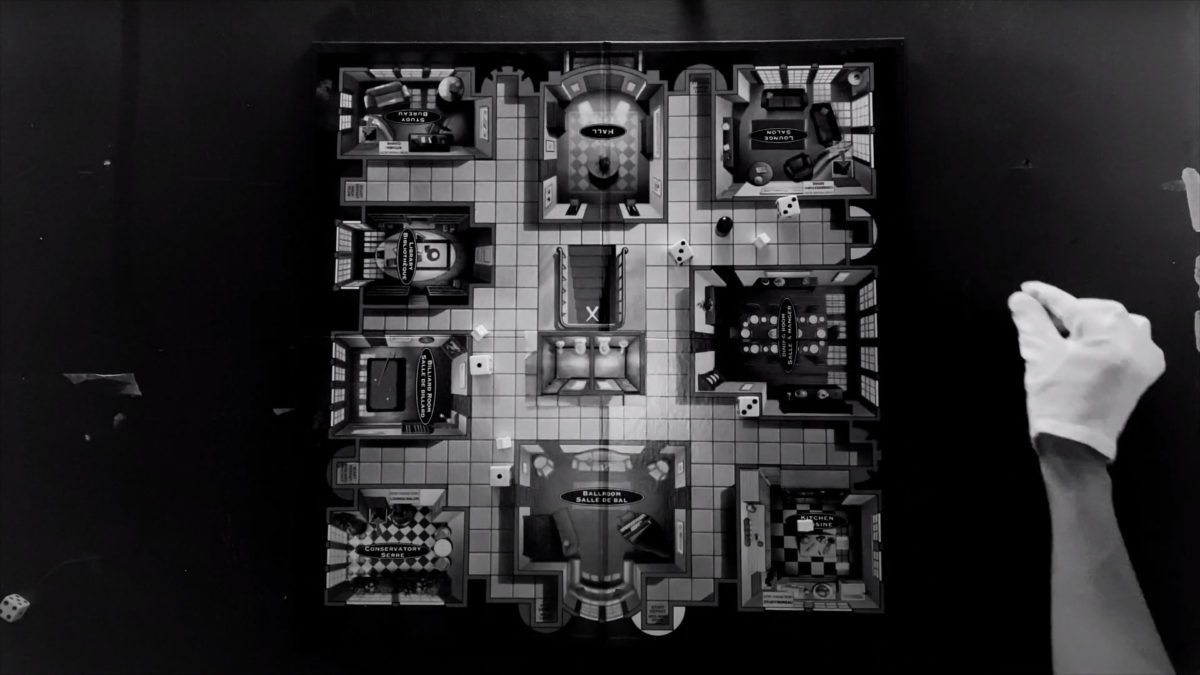Creator: Kay Slater
Exhibition: Haven’t Got a Clue Game Remix
Published: July 2021
Format: Video, Ready-Made Materials (Clue Game Pieces), Watercolour Painting, Multimedia Text and Graphics
Content Advisories: Curse words, anxiety, non-consensual touching, references to alcohol
Description of the Work
For this year’s work, Kay continues their exploration using video, which they began last year in the 2020 game-remix exhibition; Scrabblegram. In Looking For A Clue As To Why… they examine the possibilities of using ready-mades and recognizable game materials as narrative tools. Exploring themes related to social anxiety, especially in the face of mounting pressure to return to “normal” after 16 months of the global COVID-19 pandemic, Kay uses the Clue board game as a venue for a fictional social gathering where the game pieces (and their associated Clue characters) become obstacles and antagonists to the viewer/player.
The viewer attends an art opening hosted at a non-conventional heritage site; a mansion as impressive as the works on display. While they wish to attend and participate in the public event to experience the artwork and to support the artist, the cost is socialization and they must move through interactions with a set of familiar characters who regularly attend these events, but who apparently have incongruous goals.
Artist’s Essay
Using Ready-Mades
“I borrowed a copy of a 1996 North American version of the game Clue from a friend. While I didn’t limit myself to only using pieces found in the box, I did have a goal of using all the available pieces in some way. I enjoy the practice of using ready-mades to tell a story, and have fond memories of miniature doll sets and creating scenes with my toys growing up. I’d spend more time creating the worlds or homes where my dolls would live in or work at than actually playing in them. It’s definitely a playtime skill that has directly translated and continues to influence my art exploration and career as an adult. Even now, when I play boardgames, I tend to be more interested in the game pieces and the board as a miniature world, often disappointed when they are merely vehicles for complicated and wordy rules. I suffer profound anxiety when learning new games with people when I haven’t had the chance to familiarize myself with the contents of a game, the names of the game pieces, and a chance to read through the rules prior to playing. My anxiety comes from being unable to hear clearly and being slower at processing aural information especially when folks are excitedly talking over each other and sharing strategy, but solo time with a board game is a low-stakes opportunity to imagine, explore, and play – which is where I find joy and possibility.
I struggled to find a balance between showing and telling the story. In my mind, having felt anxiety at social events and as an arts worker, my narrative is very clear. The weapon tokens were figurative objects that could be placed and the rooms were already set-up on the board. Once the character cards were scanned, I translated the character portraits in a format similar to the adventure games I had grown up playing (and still enjoy to this day). But, this forced more text than I had originally planned when I created storyboards and shot my scenes. I never intended to have any sound in the video, but with so much text, I decided to add a voice over for accessibility. A lot of the text is obscured on purpose, but it’s important to me to prioritize access equally with mood. So I added the voice-over so that I could keep the visuals that induced stress and required labour without creating extra barriers for low-vision or non-visual viewers. I encourage those who can see the video to try watching it with the sound off.
Accessible Spaces
I work professionally as an arts worker and preparator in multiple gallery spaces across Coast Salish territory. In addition to my own personal art practice, I use the opportunity to work in these spaces to question traditional and colonial display and exhibition standards – especially through an accessibility and ability-focused lens. Much of the work that goes into planning and preparing exhibition spaces is hidden, and in most institutions and formal gallery spaces, display and installation structure is designed to be hidden so that the focus is on the artwork. You’re more likely to pay attention to the fact that a famous painting is crooked than the content of the painting itself if you were to visit a formal museum or gallery. It is this practice of discussing and contemplating the unseen that drives a lot of my inquiry around display.
It goes deeper than whether or not a light is correctly positioned, or if the hanging hardware on a work is hidden and flush to the wall. The environment in which a show is exhibited is easy to overlook or simply to take for granted, especially in formal spaces that use the aesthetic of the “white box” to house artwork simply and invisibly. However, this assumption is interrupted as soon as you start to consider the actual audience who needs to move through and populates the space. A visually spectacular and professionally installed show does not necessarily mean it is accessible, and with many high art, conceptual travelling exhibitions, accessibility is up to the institution and gallery to consider and execute.
This long winded walk through the frustrations and considerations of hosting a show is basically to bring you to where I was when I looked at the board as a potential gallery. My first instinct was to cover the staircase in the centre of the board, but I decided that I would bring in some stanchions to visually indicate that the staircase was inaccessible. Once the stairs were out of the way, the second most common hurdle for public spaces is accessible washrooms. While it makes sense that a board game mansion designed for little plastic effigies would have no need for toilets, the same argument could be made that limbless concave cones don’t need libraries, and ballrooms, nor do the stomachless creatures need a kitchen. Additionally, there is a specific set of social structures and rules around going to and occupying public washrooms, and so this was another essential addition to my story and set. There is shame and vulnerability in using a public washroom, there is disgust at how others use washrooms, there is punishment and politics around which communities and neighbourhoods deserve to have access to public washrooms, and frustratingly there are unnecessary arguments and judgements around who can use which room to go about their bodily needs. It was important that it be added to my gallery space and I have kept the little painting I did to bring out for future playthroughs of the game. If only essential facility upgrades were as easy as whipping out a paintbrush.
Anxiety and Cognitive Therapy
At the risk of sounding like an after school special, it was important to me that the narrative concluded by recounting the events from the evening and examining each from a different perspective than was originally presented. Since this work deals with mental illness and anxiety, I wanted to bring in an aspect of cognitive behavioural therapy where one is encouraged to review events and the thoughts associated with an event to consider not only the negative, but also the positive and neutral. While there isn’t necessarily a “satisfying conclusion” to the story, the act of reviewing an event without rumination and self-hate, open to the possibility that interactions with others can be positive or neutral is one that I hope to keep practicing – especially after distancing for 16 months and with the inevitable and looming return of in-person public events. Relearning to socialize using healthy coping mechanisms is the goal.
True Neutral
I struggled to photograph both the game board and the cards due to their texture and finish. As copyrighted material, it being difficult to repurpose, scan, or reuse any of these assets wasn’t surprising but it was certainly frustrating. Eventually I was able to defuse the lighting for filming enough so that I didn’t have a hot spot on my game board, but the cards never scanned or photographed clearly. I ended up isolating the character portraits and discarded the text and remaining card area, which ultimately worked as it gave me the opportunity to play with their names and honorifics. However, even without the text, I felt it was still too easy to gender and make generalizations about the characters based on their hairstyles and clothing. The only character who wears glasses is called Professor. The woman with a come-hither gaze? Unmarried. The stuffy figure with a bushy beard? A colonel. I appreciate that the original art from the 1949 game was likely created after the characters were named, and it’s a board game – from the 50’s. Asking for dimension and representation is asking a lot – especially from a game that originated in the UK and was popularized after the second world war – and yet I do. I do ask for more.
I considered redrawing the characters, but also I didn’t want to create a revisionist version of Clue where Miss White became a piercing enthusiast, and Professor Plum was a physical education teacher. I didn’t want to change the races or ancestry of any of the characters without research and consideration. I also didn’t really mind that the characters looked the way they did – they certainly looked like people who one find at a high profile art function. What I wanted to change was how we judged the characters by how they looked and how the names played into these perceptions. I wanted to imagine a world where appearance didn’t factor into gender and in fact, sex and gender were irrelevant to socialization. I wanted the bearded Colonel to be named Miss Scarlett, rocking a beard without it being notable (unless it was a very excellent and noteworthy beard). I wanted Mistress White to be the name of a maid-themed sex worker coming to the event before her shift started, and for her age and specific profession to be a non-factor. And the more I thought about it, the more I realized that the thing that I wanted to do away with wasn’t the family names but rather the honorifics. And so I did.
Within my own dollhouse, there is only one gender.
My sandbox. My toys. My rules.
Process Photos

Project Files
- Looking For A Clue As To Why…
- Transcript for Looking For a Clue As To Why…
- Artist Essay (video)
- Transcript to Exhibition Video.
